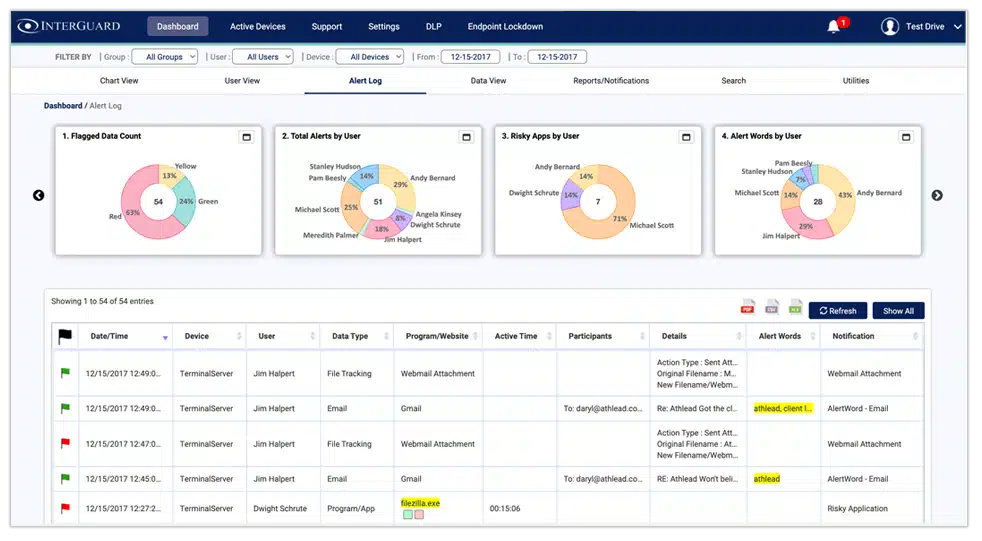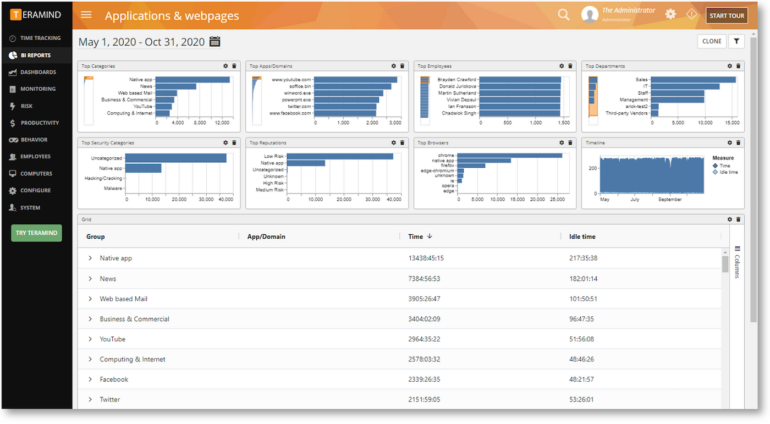Recommended News On Deciding On Employee Monitoring Company
What Is Employee Monitoring Software? And How Do I Pick The Best One?It's a kind of software that enables organizations to monitor, track, and record the actions of their employees. It allows employers gather data regarding various aspects of employees' behaviour, including internet usage as well as application usage. Keystrokes can also be tracked as well as screen shots. The primary purpose of employee monitoring software is to increase productivity, ensure conformity with policies, safeguard sensitive information, and address concerns about security. When selecting employee monitoring software, you should consider several aspects. Consider these important factors features. Find the features you need according to the needs of your company. Some of the most common features are activity monitoring and blocking websites. Other features include keystroke logging and tracking software as well as email monitoring and reports generation. Make sure you prioritize features that are in line with your monitoring goals.
Compliance and Privacy. Ensure that your program adheres to the applicable moral and legal guidelines. You should familiarize yourself with the applicable laws within your jurisdiction. For example the laws on data protection and privacy laws. Look for software that provides flexible and transparent settings to protect the privacy of employees.
User-Friendliness. Take into consideration the ease of use and the accessibility of the software. The time will be reduced and the setup process streamlined if you have a simple interface and set-up process. Consider customizable dashboards with simple reporting tools that will assist you with navigation and understand the data.
Integration and compatibility – Check whether the software integrates seamlessly with your existing infrastructure and the systems you are using. This includes operating systems as well as email clients. Compatible monitoring ensures smooth operations without disrupting day-to-day routines.
Data Security- Review the software security measures in order to ensure safety of the collected data. Security protocols, encryption, safe storage of data, as well as access control are important. Check that the software company is known for its strong data protection record and has robust security measures.
Scalability - Consider the software's capacity to grow in line with your business. If you plan to expand your workforce or expand sites in the near future, choose a software solution that is easily scaled up to meet evolving requirements.
Capabilities for Analytical and Reporting Check the analytical and reporting capabilities of the program. You should look for features that offer detailed information about the productivity of employees and their time allocation. Customized analytics and reports can assist you in making informed decisions and identify improvements.
Customer Support - Determine the level of customer service provided by the vendor. You can evaluate their accessibility, responsiveness and technical assistance that they provide. Support for customers is essential to ensure quick resolution of issues.
Cost- Be aware of the pricing structure for the software. It could be a one-time fee that is subscription-based, or usage based. Learn about the pricing structure, including any additional charges for support, updates or additional features. Your budget should be balanced as well as the worth of features with the amount you are able to afford.
Transparency and Communication with Employees Keep clear communication and openness when working with employees in relation to the monitoring software. Transparently explain the purpose the scope and the expectations of the monitoring. Address any concerns and make sure they know that privacy rights will still be respected.
By evaluating these factors, it is possible to make an educated decision that is in line with your company's particular needs and protects employees' privacy while meeting all lawful requirements. Follow the recommended time tracking monitoring software for site tips.

What Are The Distinct Aspects Of Employee Monitoring Software?
Software designed to monitor employee activity has many features that can be used to track and analyze the behavior of employees. Different software solutions may offer various features, but these are the most popular. It provides an in-depth description of how employees utilize their time.
Keystroke Logging - Keystroke recording records each keystroke employees type. It helps to spot productivity issues, detect illegal activity, and provide evidence in the event of need.
Screenshots and Screen Recordings Certain software programs capture screen shots or record the screens of employees on a regular basis. This feature is useful for monitoring employee productivity, verifying compliance or troubleshooting issues.
Internet Usage Tracking: This feature allows employees to track their online activities including the websites they visit, the searches they conduct and downloads. It can help identify excessive non-work related browsing, possible security risks or violations of policies.
Application Usage Tracking - This feature monitors the apps that employees use during their work time. It gives insight into the applications that are frequently used and helps identify any unapproved or excessive use of the application.
Email Monitoring allows employers to check all emails sent by employees. This includes received and sent emails, email attachments, received emails, attachments to emails and email content. It can help ensure conformity with policies of the company and prevent leaks of data and investigate any suspicious activities.
File and document tracking - This feature tracks modifications, transfers, and modifications to files. It assists in protecting sensitive data by monitoring collaboration between documents and monitoring compliance with data security policies.
Remote Monitoring is a feature that lets employers monitor their employees, even if they are working from afar or at various places. Employers can track employees' activities and productivity no matter where they are.
Productivity Analysis. Programs for monitoring employees often include productivity analysis features which give insight into employee work patterns and levels of productivity. These analyses allow for the analysis of areas that can be improved, and also help to optimize workflow.
Analytics and ReportingThe robust analytics and reporting tools generate detailed reports and visualizations that are based on data. These reports offer valuable insight into the performance of employees as well as resource allocation and time management.
Compliance and Policy Management - Software solutions can be set up to conform with company policies, regulations, and other industry standards. Employers can establish and enforce policy related to the use of computers as well as internet access and security of data.
Alerts/Notifications: Alerts/notifications alert employers or managers when certain events or activities occur. They could, for instance, alert employers or managers when certain events or activities occur.
You should be aware that different employee monitoring software may have different functions and features. When selecting software, make sure that the features you choose are in line with your monitoring goals as well as in compliance with the ethical or legal guidelines applicable to your jurisdiction. Follow the most popular time tracking monitoring services for website examples.

What Is The Best Software For Monitoring Employees? Comply With The Compliance And Privacy Law?
Respecting privacy and compliance laws is a critical element of employee monitoring software. The legal requirements for compliance will differ from one jurisdiction to the next, however there are a few common ways that software for monitoring employees adheres to the laws on privacy and compliance Consent and Notification - A majority of jurisdictions require the informed consent of employees as well as prior notice of any monitoring activities. Monitoring software for employees typically includes features that enable employers to clearly communicate their monitoring policy to employees. This may involve providing written notices, obtaining consent through consent forms or even implementing an employee handbook that outlines the procedures for monitoring.
Transparent Monitoring Policies- Employee monitoring tools help promote transparency. They make sure that employees are aware of what kinds of information are being collected and why, as as the extent of the monitoring. Employees can better know their rights to privacy and the limitations of monitoring when the policies are clear and comprehensive.
Data minimization is often employed by employee monitoring software to ensure compliance with privacy laws. The software collects and retains only the necessary data, while avoiding irrelevant or excessive information. By limiting data collection to the essentials to monitor purposes the software decreases privacy risk and promotes compliance.
Certain employee surveillance software anonymizes, or aggregates, information to ensure employees' privacy. Anonymization eliminates personally identifiable data (PII) from data, making it impossible to link data with specific individuals. Aggregation blends data from several employees to give insights on the level of a group without single out specific individuals.
Secure Data Storage and encryption The protection of data is a priority for monitoring software designed to monitor employees. To protect collected data from unauthorised access, breaches or accidental disclosure, it utilizes encryption and secure storage methods. This includes security for data while in transit and at home.
Access Controls and Restricted Privileges - To ensure compliance employee monitoring software typically provides access controls and privileges that are granular. Employers can restrict access to monitoring data to only those who need it legally, such as HR administrators or HR personnel.
Employee Rights & Remedies: Respecting the rights of employees is vital for ensuring that they are in compliance with the privacy and compliance laws. Many employee monitoring programs include features that allow employees to access their own personal information and make corrections, or even file complaints. This permits employees to take action and exercise their rights should they feel their privacy rights have been violated.
Conformity with Data Protection Regulations – The employee monitoring software is built to conform with applicable data protection laws like the General Data Protection Regulations in Europe or the California Consumer Privacy Acts in the United States. The compliance process includes the implementation of measures to protect personal data and honor data subject rights.
Alongside using employee monitoring tools businesses should also seek out experts in the field of law and remain up to date on the laws and regulations that apply to their area of responsibility. Complying to privacy and compliance regulations requires a holistic approach that goes beyond software. This includes clear policies, employee training and ongoing monitoring of compliance. View the top rated employee monitoring company for website info.
